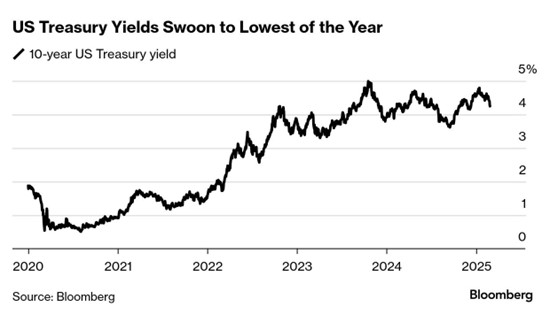
As Spring Heats Up Bond Yields Face a Cool Down
March 3, 2025
 By Krista Biernbaum, CFP®. CIMA®
By Krista Biernbaum, CFP®. CIMA®
Investment Management Officer
We are officially past the two coldest months of the year. The days are starting to get longer, warmer, and Spring is right around the corner. Also, with daylight savings time this coming weekend, we ‘Spring ahead’ and gain an additional hour of sunlight. There is light at the end of the tunnel and brighter times ahead for us here in the Midwest. With regard to the financial markets, the path forward is becoming less rosy than it was a few weeks ago. As a result, bond yields reached their lows for the year on Friday. Let’s discuss.
Bond Yield Recent History
Below is the path of the 10 year Treasury yield over the past few years from Bloomberg. You will notice a lot of volatility in interest rates during this time. The 10 year reached an all-time low of 0.5% in August 2020, then started to gradually increase. Fast forward to 2022. Yields took off with the Federal Reserve aggressively raising rates to combat a 40 year high in inflation. The10 year briefly hit its cycle high of 5% in October 2023 before declining as a ‘Fed pivot’ was on the horizon. Yields reached 2024 lows in mid-September before the Fed officially announced its first rate cut of 50 basis points (0.5%). Since then, longer-term yields have been on an upward trend, while short-term rates declined. That is, until the past few weeks.

Short-term rates are relatively flat this year with the Fed on hold. Longer-term rates hit their 2025 high in mid-January around 4.8% and have been on a downward trend since. The 10 year Treasury note ended February at 4.22%, its low for 2025. Why is this? Contrary to what one may think, the Federal Reserve does not control longer term rates. Monetary policy directly affects short-term rates (i.e. why they are largely unchanged with the Fed on hold). Longer-term interest rates are influenced by economic growth, inflation, and the supply of debt from our growing budget deficit.
The Role the Economy Plays on Yields
Recently, fears of a U.S. economic slowdown resurfaced as various economic reports have surprised to the downside. Consumer spending is slowing, and consumers are becoming less confident in the current economy and expectations for the future. Why does this matter? Consumer spending accounts for over two-thirds of our economic growth. In addition, core inflation remains sticky and has largely moved sideways since the second half of 2024. All of this together - in conjunction with the uncertainties surrounding tariffs and potential fiscal policy changes - has investors on edge. In periods of uncertainty, Treasuries are seen as a safe haven asset. Bonds are positive in the first two months of the year on a total return basis while some areas of the stock market moved into negative territory. This inverse relationship means fixed income returned to one of its traditional roles of providing downside protection in challenging times.
We recognize there are uncertainties and the path forward for the U.S. economy is not yet defined. As a result, we expect continued volatility in the financial markets as policy unfolds and the implications for economic activity and inflation. In the meantime, let us help ensure your portfolio is well positioned for the uncertain and bumpy path that lies ahead. If you have not reviewed your portfolio this year, give your Wealth Management Advisor a call today. Helping you safely navigate your path to your financial goals matters to us.